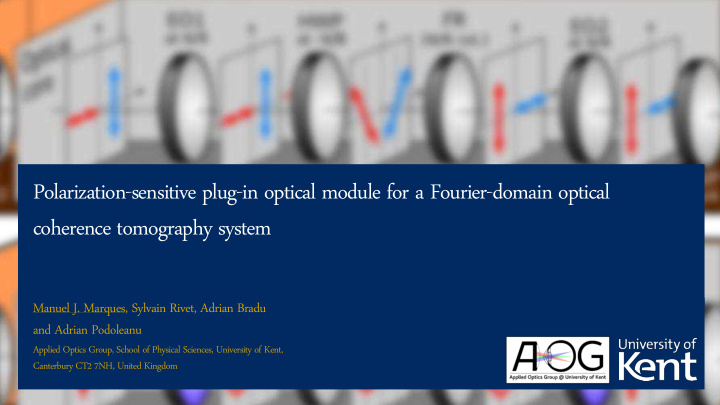



Polarization-sensitive plug-in optical module for a Fourier-domain optical coherence tomography system Manuel J. Marques, Sylvain Rivet, Adrian Bradu and Adrian Podoleanu Applied Optics Group, School of Physical Sciences, University of Kent, Canterbury CT2 7NH, United Kingdom
Motivation • OCT: image translucent (@NIR) structures, resolution ~ 1-10 μ m, few mm penetration. • Functional extension: P olarisation- S ensitive OCT (PS- OCT). • With PS-OCT we can study the retardance and axis orientation of samples. Potential applications include: • Measuring the density of the retinal nerve fibre layer; • Assessing burned tissue in dermatology; • Characterisation of polymers (NDT). 2
PS-OCT systems: can one add the functionality to an existing OCT system? (as in… a plug -in module?) PS-OCT system 3
PS-OCT systems First publication: Hee et al. (1992) • Sample illumination with circularly polarised light . • Bulk optics implementation. • 2 orthogonal states are interrogated w/ 2 PDs . Since then: • Fibre -based OCT systems; • Interferometer interrogated in frequency- domain . 4
Challenges: • Fibre-based PS-OCT systems introduce additional complications! • External factors (temperature, stress) affect the birefringence of SMFs; • Polarisation-maintaining fibres help but introduce PMD (ghosting of images). • Spectral-domain detection: • Complexity is increased (eg. two spectrometers required). • Module must be able to be installed on any OCT system with minimal modifications required! 5
Our first solution… … sequentially measures the 2 orthogonal states before (Version 1.0) power is collected back to the interferometer. (only 1 detector required!) With some limitations, however: • Switchable decoder was too slow to ensure in-vivo imaging! • 2 propagating paths (encoding/decoding) had to be spatially separated . Marques et al. , Opt. Lett. 40 (16), 2015. (and presented @ PW, BiOS 9697-55) 6
Version 2.0: in-line configuration (concept) • Rotating element - a combination of 2 EO modulators; (switching times < ms achievable) • Non-reciprocal design: Faraday rotator ensures encoding and decoding path can be through the same elements (no need for spatial separation). Rivet et al. , J. Opt. 18 (6), 2016. 7
Principle of operation: forward propagation Starting with a Circularly polarised linearly probing beam, polarised state. regardless of the setting of ϕ EO . 8 •
Principle of operation: backward propagation After the QWP it is decomposed in two orthogonal components. At any given time, only one Arbitrary elliptical of them is injected back polarisation state into the object arm fibre. returning from the sample. 9 •
Full polarization characterization is now possible! (but with some caveats for the measurement of θ…) Three options: • Fast switching time: phase extraction from the OCT signal. (phase doesn’t change between the two measurements) • Slow switching time: use the first surface of the sample as a reference! • But what if the “measured retardance” on the first surface is zero? 10
Measurement errors Rivet et al. , J. Opt. 18 (6), 2016. • Switching time must be shorter than the period of: • The random phase variation in the interferometer (for the measurement of θ ) ; • The variation in the fibre disturbances. • However… these errors are miniscule in comparison with those stemming from the chromatic response of the elements! 11
Chromatic response Rivet et al. , J. Opt. 18 (6), 2016. EO modulators Faraday rotator Chromatic responses of the components in the module have been modelled as linear. 12
To conclude… • Measurement errors within the module: • can come from fluctuations in the fibre properties; • but stem mostly from the chromatic response of the polarization elements (this is the case with every PSOCT system!!). • Measurement procedure is still sequential! • Version 2.0 of our polarization sensitive module is a significant improvement over version 1.0: • Inline design (true “ plug-in ” module); • Switchable decoder with a high switching rate: complete polarization characterization, and no bottleneck introduced in the speed of the OCT system! 13
Thank you! AOG (and friends) in August 2016. Slide Douro Valley (near Pinhão), Portugal – September 2016 14
Recommend
More recommend